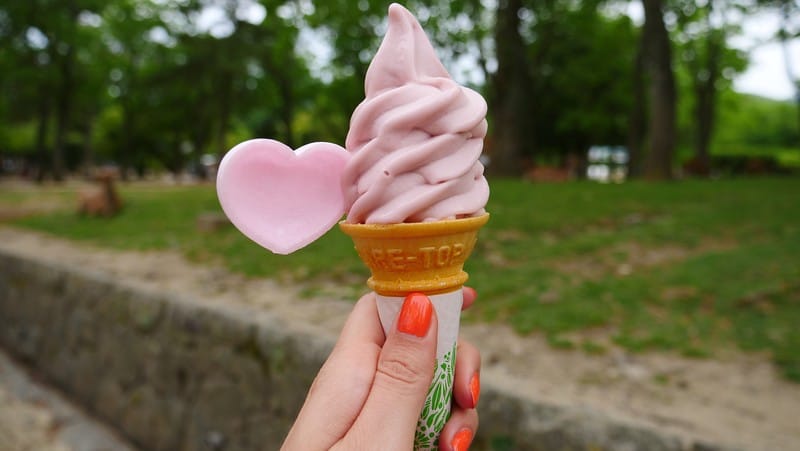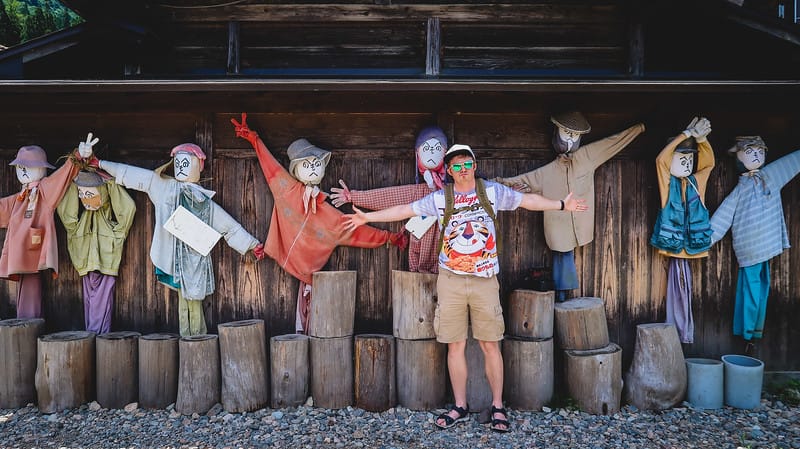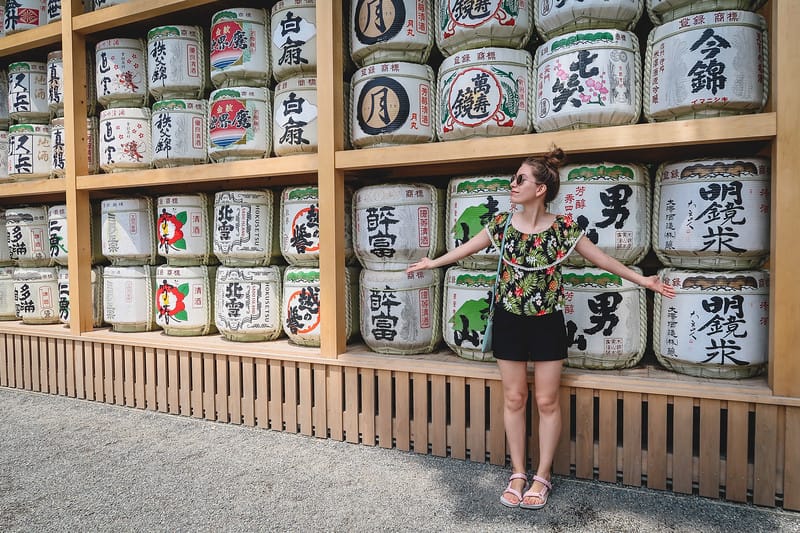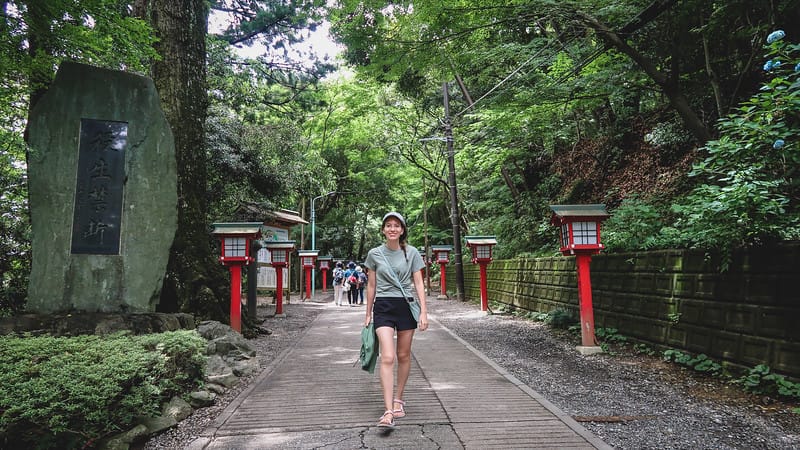Oh, summer in Japan! That time of year when you hear the tune of cicadas any time you set foot outside your door, and when eating multiple ice cream cones a day is perfectly acceptable. Japan in summer is when locals begin to don mega-visors, UV umbrellas, arm protector sleeves and hand towels because it’s so hot and humid that you literally need to wipe the sweat off your brow. In short, summer in Japan is serious business!
As you probably already know, Sam and I love finding a good airline deal, so when we found cheap flights to Japan over the summer months, we booked it! I mean, we had already spent time backpacking in Southeast Asia – surely we could handle the heat, right?
Well, boy, oh boy, was summer in Japan a lot hotter than we were expecting!
We were there from May to July, and while things started out easy enough, sweltering temperatures soon followed.
May was springlike; we enjoyed warm days with a light breeze, perfect for long days of strolling. June marked the start of the rainy season with the arrival of ‘tsuyu’, also known as the plum rain. At this point, the non-rainy days were starting to get hot and muggy, but the temperatures would pale in comparison to what we would experience in July.
July brought heat and humidity like I hope to never experience again. There’s a day etched in my memory when the ‘feels like’ temperature was 48°C! I could not believe the temperatures I was reading on my phone and needless to say I could not function.

How to Survive Summer in Japan
I’m not going to tell you summer travel in Japan is easy, but there are ways to make it a bit more bearable. Though I’d recommend visiting Japan in the shoulder season, I realize that for some people, summer might be the only time of year they have to travel to Japan. We can’t always be choosy with the time of year we have to travel, so if you’re going to visit Japan in summer, here are my tips!
1) Plan to visit cooler destinations
I would advise against lingering in the big cities over the summer months. It’s not just the high temperatures and humidity, but the fact that cities trap and retain heat and it becomes a sweltering concrete jungle with nowhere to escape (okay, maybe a local park).
Our strategy for summer travel in Japan was to include some cooler destinations. We still wanted to see the big cities like Tokyo, Kyoto and Osaka, but we also included mountain escapes (we day-tripped to Mount Takao and visited Nikko) and we spent time in the Japanese Alps (specifically Takayama and Shirakawa-go).
If you’re really serious about finding some cooler temperatures, you can travel further north to Hokkaido, Japan’s second-largest island and northernmost prefecture. Summer temperatures there average about 20°C!
2) Go sightseeing in the early morning / late afternoon
If you want to avoid the hottest times of day, you’re going to have to adjust your sightseeing schedule. We started doing our sightseeing in the early hours of the morning and the late hours of the afternoon in order to avoid the heat (a strategy that we adopted during our very first backpacking trip in Southeast Asia).
This worked well with free attractions like hikes to scenic viewpoints, visits to local shrines, and some neighbourhood exploration.
This is obviously not something that can be done if you’re wanting to visit a particular temple, palace, or attraction that has set hours of operation, but we planned accordingly.
Visiting some attractions at sunrise also had the added benefit that we had these places almost all to ourselves. It was nice getting to experience places like Fushimi Inari Taisha and Arashiyama Bamboo Forest with hardly anyone else there.

3) Include some indoor activities in your schedule
If you’re visiting Japan in summer, there will be some days when it’s unbearably hot and humid and other days when you experience torrential downpours. On days like these, it’s good to have some indoor activities where you can stay cool and dry.
We opted for indoor activities like cat cafes, retro arcades, and shopping centres – any place that had AC!
You can also consider museums (we enjoyed seeing robots in Odaiba), art galleries, and a little rest and relaxation by staying in a ryokan.

4) Eat summer dishes to stay cool
One thing we noticed in Japan is that the cuisine is very seasonal and that there are certain summer dishes to help you cool down.
These include things like cold ramen noodles with fresh vegetables, shaved ice, mochi stuffed with fresh fruit, and eel which is said to help you recover from summer heat fatigue.
Another unique summer food experience in Japan is ‘nagashi somen’. This is a thin white noodle that is placed on a bamboo slide with water. As these noodles come by, you have to catch them with chopsticks and dip them in a sauce.
And we can’t forget soft-serve ice cream and all the unusual flavours available in Japan.
5) Carry a UV umbrella or parasol
Prior to visiting Japan in summer, I had no idea that UV umbrellas were a thing, but then I started noticing that all the umbrellas people were carrying had a silver UV blocker (looks like this).
I used my rain umbrella to shield myself from the sun, but it doesn’t quite have the same effect since regular umbrellas actually trap the heat!
If you burn easily, do as the locals do and grab a UV umbrella to sightsee during the hottest times of day.

6) Pack a light summer wardrobe
When packing, think light and breezy, with the chance of rain. That means breathable materials like linen and light cotton for everyday wear, fast-drying athletic shirts for active days, and things like a rain jacket and umbrella for the heavy rains.
You’ll also want to pack a sunhat, sunglasses and sunscreen.
7) Bring comfortable shoes
I don’t know about you guys, but my feet swell in the heat and humidity! For summer sightseeing in Japan, I’d recommend packing comfortable walking sandals. I packed a few different shoes but ended up mostly wearing my Tevas.
8) Carry a fan
We saw lots of locals using mini battery-powered handheld fans (like these), but a simple paper fan will do. If you’re looking for a free fan to do the trick, they usually hand them out at beauty and skin-care stores as part of their marketing.
9) Hydrate, hydrate, hydrate!
We always made sure to bring lots of water with us, and we also found ourselves stopping at convenience stores and vending machines to grab sports drinks.
The nice thing about travel in Japan is that you’re never too far from a 7Eleven, Family Mart or Lawsons where you can buy a drink and get a break from the heat in an air-conditioned space.
Pros of visiting Japan in summer
This blog post is starting to read like a huge warning against visiting Japan in summer, so let’s take a step back and talk about some of the pros:

- Lower rates for accommodations. Most people flock to Japan in spring for cherry blossom season and fall for autumn foliage. However, since there are fewer tourists during the summer months, you can find better deals on accommodations.
- There are lots of summer festivals. Numerous ‘matsuri’ take place in Japan during the summer months, the biggest of which are accompanied by floats, parades, music, food and general festivities.
- You can see lots of fireworks. The Sumida River Fireworks Festival which is held in Tokyo each July is the oldest recorded fireworks festival in the country, dating back to 1733, and a great reason to visit Japan in summer.
- It’s music festival season. There are lots of summer music festivals to attend, two of the biggest being Fuji Rock and Summer Sonic.
- Climbing season on Mount Fuji. The official climbing season is between early July to mid-September when the trails and mountain facilities are open. During this brief window, the mountain is typically snow-free and the weather is milder. The perfect time to tick hiking Mount Fuji off your bucket list!
- You can cool down in beer gardens. That’s right – outdoor patio season is in full swing.
- Enjoy beach time. If you relish the heat, you may want to head down to Okinawa for surf and beach time.
- It’s cooler in the north. This is a great excuse to visit Northern Japan – in Hokkaido the summer average is around 20°C.

Summer Logistics Cheat‑Sheet: Getting the Practical Stuff Right
Moving Around: Air‑Con on Rails
- Shinkansen & Limited Express Trains – Fully air‑conditioned, punctual to the minute, and blissfully quiet. Grab an ICOCA/Suica card or pre‑book a JR Pass if you’re covering long distances; both let you skip ticket queues and retreat to chilled carriages in seconds.
- Local Subways & Buses – Also cooled, but platforms can feel like saunas. Keep a tenugui hand towel handy for forehead mopping while you wait.
- Mountain Escape Hack – When city heat becomes unbearable, hop on a high‑altitude train like the Alpine Route (Toyama ↔ Nagano) or the Hakone Tozan Line; temperatures drop 5–8 °C the moment you climb above 800 m.

Booking a Cool Night’s Sleep
| Stay Type | Pros | Summer Watch‑outs |
|---|---|---|
| Business Hotels | Reliable A/C, free ice machines, under‑¥7,000 rooms outside Tokyo | Tiny windows—air out clothes in the bathroom with the fan on |
| Ryokan | Tatami serenity + multi‑course dinner | Ask in advance if the room has air‑con; some rely on fans |
| Capsule Hotels | Budget‑friendly, novelty factor, powerful ventilation | Limited luggage space; store suitcases in lockers |
| Minshuku (Family Inns) | Warm hospitality, regional cuisine | May lack A/C in rural areas—confirm before booking |

Beware the Summer Critters
- Mosquitoes: Peak season is June‑September. Convenience stores sell pocket‑size bug sprays and “mosquito coil” patches you can stick on clothes or backpacks.
- Kumadori Bees & Horseflies: Common in the countryside. Wear light‑coloured clothing (they’re drawn to dark hues) and avoid scented lotions.
- Jellyfish: If you’re beach‑bound in August, slip on a rash guard; coastal lifeguard stations usually post daily sting alerts.

When is the best time to travel in Japan?
Each season comes with its own pros and cons. You can get a better idea of temperatures across Japan by month here.

Spring: Springtime in Japan brings milder temperatures and cherry blossom season, but there’s also a higher number of visitors. Golden Week, a span of 4 national holidays over the course of 7 days, also happens in the springtime, making it one of the busiest times of year to travel in Japan.
Summer: As you already know from reading this article, summertime in Japan brings an oppressive heat and humidity with strong rains and typhoons, but you can escape to cooler destinations in the north of the country. One of the advantages of summer in Japan is that there are many music festivals, cultural festivals and fireworks festivals. Summer brings a busy calendar with lots of events to choose from.
Autumn: Autumn in Japan means the temperatures begin to cool down, though it’s still warm with a risk of typhoons earlier in the season. Then there’s the autumn foliage, with the colours arriving in the northern part of the country first and slowly spreading south. The foliage viewing opportunities attract both national and international visitors and one epic place to watch the magic unfold is along the Tateyama Kurobe Alpine Route.
Winter: Then there’s winter in Japan. The best places to experience snow are in Hokkaido to the north, the Japanese Alps, and the coast facing the Sea of Japan. Winter brings fewer tourists, but if you’re okay bundling up, you can enjoy crisp winter days.
FAQ: Visiting Japan in Summer — Heat, Rain, Festivals & How to Cope
Thinking about Japan between June and August (or you’ve already booked those cheap flights)? Here are the questions travelers actually ask—and the practical answers to help you survive and still have fun.
Is visiting Japan in summer a terrible idea?
Not terrible—just different. It’s hot, humid, and occasionally stormy, but it’s also festival season, fireworks galore, beer gardens, Mt. Fuji’s climbing window, and cheaper hotel rates than spring/fall. If you plan smart (cooler destinations, early/late sightseeing), it’s absolutely doable.
How hot does it really get?
Expect sticky, hair-dryer heat—especially in cities. June is warm and muggy (rainy season), while July can feel brutal; “feels like” temps can soar into the 40s °C. Concrete traps heat, so parks and riversides feel better than city cores in the afternoon.
When are rainy season and typhoons?
Rainy season (tsuyu) typically hits June (give or take by region): frequent showers, steamy non-rainy days. Late July–September brings occasional typhoons, mostly in the south/coast. Build a few indoor “Plan B” days and keep flexible tickets.
Where can I escape the heat without skipping Japan?
Head north or up: Hokkaido averages ~20 °C in summer. Closer to Tokyo, try Nikko or Mount Takao for day trips, and the Japanese Alps (Takayama, Shirakawa-go) for cooler overnights. Even a few hundred meters of elevation drops temps noticeably.
How should I time my sightseeing?
Treat midday like siesta. Do outdoorsy sights at sunrise and late afternoon/evening; slot museums, cafés, shopping arcades, and karaoke in the midday heat. Bonus: sunrise at places like Fushimi Inari or Arashiyama = fewer crowds and prettier light.
What should I pack to survive the weather?
Think light and breezy: linen/cotton, quick-dry athletic tops, a compact rain jacket, UV parasol/umbrella, sunhat, sunglasses, and high-SPF sunscreen. Add comfortable walking sandals (swelling is real), a mini fan or paper uchiwa, and a tenugui hand towel.
Any smart food and drink moves to stay cool?
Yes! Cold ramen and somen, kakigōri (shaved ice), fruit-filled mochi, and even eel (said to fight heat fatigue). Hydrate constantly—Japan’s vending machines and convenience stores are everywhere, and sports drinks help replace electrolytes. Soft-serve sampling is basically medical at this point.
What indoor activities are worth penciling in?
Cat cafés, retro game arcades, art museums, mega-bookstores, depachika (food halls), and ryokan downtime. In Tokyo, Odaiba’s tech/museums are great for AC days; in Kyoto/Osaka, aim for galleries, markets, and hands-on workshops (tea, wagashi, pottery).
How is getting around—will trains save me?
Yes. Shinkansen and limited-express trains are blissfully air-conditioned. Subways and buses are cooled too (platforms can be sauna-ish). Grab an IC card (Suica/ICOCA) for quick tap-in rides, and retreat to chilly carriages whenever you’re wilting.
Any gotchas I should know (critters, beaches, Fuji)?
Mosquitoes love June–Sept (pick up pocket spray at any konbini). If you’re beach-bound in August, some coasts get jellyfish—rash guards help. Mt. Fuji’s official season is early July–mid-September; book huts/transport in advance and pack layers—summit temps are cold, even in July.
What are the upsides of summer I shouldn’t miss?
Matsuri (parades, food stalls, dancing), massive fireworks shows (Sumida River in Tokyo is historic), music festivals (Fuji Rock, Summer Sonic), beer gardens, and often lower hotel rates than cherry-blossom or autumn-foliage season.
Can you suggest a heat-smart 7-day outline?
Try: Tokyo (2) with sunrise temples + indoor afternoons → Nikko or Takao day trip (1) → Japanese Alps: Takayama/Shirakawa-go (2) → Kyoto/Osaka (2) with dawn shrines and evening markets. If heat is punishing, swap the Alps for Hokkaido and keep cities to mornings/evenings.
Have you visited Japan in summer?
What would you say is the best season to travel to Japan?

Japan is literally one of my dream destinations. Hopefully one day I will finally visit!
xoxo
jess
The Crown Wings | UK Travel & Lifestyle Blog
Nice post! I haven’t been to Japan yet but it’s definitely on my list.
Thanks for sharing! The last time I was there was end of summer and crowds were manageable and weather was quite bearable. Great time to watch a sumo match!
I visited last year in Japan and enjoyed a lot indoor activities hope to visit again this year. Thanks
Great info! We plan to visit Japan next year.
I’d rather visit during the winters. Loved your blog.
Definitely the weather conditions weren’t favorable…but I’m sure Japan is worth having fun.
Great post, japan and its people are lovely, I would also prefer to visit somewhere around spring.
Thanks for sharing your insights and tips. I’ve long wanted to visit Japan in the summer, but have always been put off by what I’ve read about the heat. Your tips will come in very useful if I do go someday.
Thanks for sharing such a beautiful informations with us. Glad to know about the advantages of traveling to Japan during the summer season. Your ideas are really cool to escape from hot & humid weather of Japan and short descriptions of other seasons are also one of the key attractions in your article.
Thanks for sharing your advice on summer weather in Japan! Each season has its advantages and disadvantages!
Sightseeing in the morning is my fave part when visiting other places. It makes me relax and calm all the time.
Great tips! I’ve always wanted to visit Japan during the summer, but the heat can be intimidating. Your advice on staying hydrated and planning indoor activities is super helpful. I’ll definitely keep these in mind for my trip!
Great tips on surviving the Japanese summer! I never thought about wearing a hat and staying hydrated as much as possible. I’m planning my trip for July, so this advice is super helpful. Can’t wait to explore the festivals and enjoy the unique summer cuisine! Thanks for sharing!